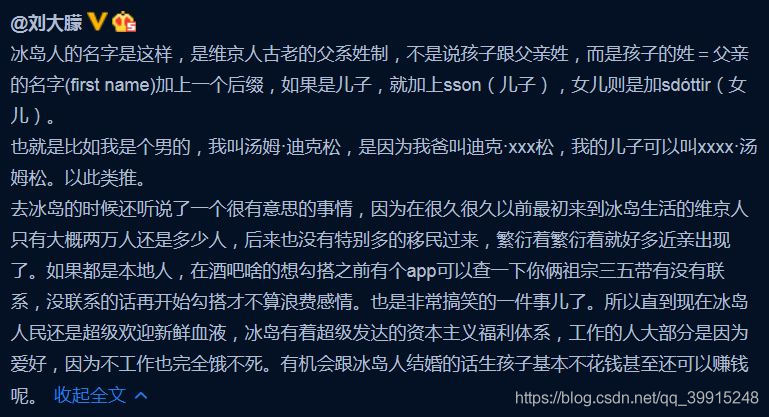L2-030 冰島人 (25分)(C語言)
2020-08-10 14:12:25
L2-030 冰島人 (25分)
2018年世界盃,冰島隊因1:1平了強大的阿根廷隊而一戰成名。好事者發現冰島人的名字後面似乎都有個「松」(son),於是有網友科普如下:
冰島人沿用的是維京人古老的父系姓制,孩子的姓等於父親的名加後綴,如果是兒子就加 sson,女兒則加 sdottir。因爲冰島人口較少,爲避免近親繁衍,本地人交往前先用個 App 查一下兩人祖宗若幹代有無聯繫。本題就請你實現這個 App 的功能。
輸入格式:
輸入首先在第一行給出一個正整數 N(1<N≤10
5
),爲當地人口數。隨後 N 行,每行給出一個人名,格式爲:名 姓(帶性別後綴),兩個字串均由不超過 20 個小寫的英文字母組成。維京人後裔是可以通過姓的後綴判斷其性別的,其他人則是在姓的後面加 m 表示男性、f 表示女性。題目保證給出的每個維京家族的起源人都是男性。
隨後一行給出正整數 M,爲查詢數量。隨後 M 行,每行給出一對人名,格式爲:名1 姓1 名2 姓2。注意:這裏的姓是不帶後綴的。四個字串均由不超過 20 個小寫的英文字母組成。
題目保證不存在兩個人是同名的。
輸出格式:
對每一個查詢,根據結果在一行內顯示以下資訊:
若兩人爲異性,且五代以內無公共祖先,則輸出 Yes;
若兩人爲異性,但五代以內(不包括第五代)有公共祖先,則輸出 No;
若兩人爲同性,則輸出 Whatever;
若有一人不在名單內,則輸出 NA。
所謂「五代以內無公共祖先」是指兩人的公共祖先(如果存在的話)必須比任何一方的曾祖父輩分高。
輸入樣例:
15
chris smithm
adam smithm
bob adamsson
jack chrissson
bill chrissson
mike jacksson
steve billsson
tim mikesson
april mikesdottir
eric stevesson
tracy timsdottir
james ericsson
patrick jacksson
robin patricksson
will robinsson
6
tracy tim james eric
will robin tracy tim
april mike steve bill
bob adam eric steve
tracy tim tracy tim
x man april mikes
輸出樣例:
Yes
No
No
Whatever
Whatever
NA
#include "stdio.h"
#include "stdlib.h"
#include "string.h"
#define N 150001
char ch[3]={'-','1','\0'};
unsigned int hash(char *str)
{
unsigned int b = 378551;
unsigned int a = 63689;
unsigned int h = 0;
while (*str)
{
h =( h * a + (*str++))%N;
a *= b;
}
return h;
}
int find(char s[][21],char t[21])
{
int i,k;
k=hash(t);
while(strcmp(s[k],ch)!=0)
{
if(strcmp(t,s[k])==0)
return k;
k=(k+1)%N;
}
return -1;
}
int main()
{
int n;
char s[N][21],t[N][21];
char tem1[21],tem2[21];
char temp1[21],temp2[21];
int t1[N],t2[N],top1,top2;
int i,j,k1,a,b,c,d,x1,x2,h,k2,len,len1,len2;
int m;
scanf("%d",&n);
for(i=0;i<N;i++)
{
strcpy(s[i],ch);
strcpy(t[i],ch);
}
for(i=0;i<n;i++)
{
scanf("%s",tem1);
scanf("%s",tem2);
h=hash(tem1);
while(strcmp(s[h],ch)!=0)
h=(h+1)%N;
strcpy(s[h],tem1);
strcpy(t[h],tem2);
}
scanf("%d",&m);
for(i=0;i<m;i++)
{
scanf("%s",tem1);
scanf("%s",tem2);
scanf("%s",temp1);
scanf("%s",temp2);
k1=find(s,tem1);
k2=find(s,temp1);
if(k1==-1||k2==-1)
{
printf("NA\n");
}
else
{
a=strlen(t[k1]);
b=strlen(tem2);
c=strlen(t[k2]);
d=strlen(temp2);
x1=1;
if(t[k1][a-1]=='n'||t[k1][a-1]=='m')
x1=0;
x2=1;
if(t[k2][c-1]=='n'|| t[k2][c-1]=='m')
x2=0;
if(x1==x2)
printf("Whatever\n");
else if(((t[k1][a-1]=='f') &&(t[k2][c-1]=='m'))||((t[k2][c-1]=='f') &&(t[k1][a-1]=='m')))
printf("Yes\n");
else{
top1=0;
top2=0;
t1[top1]=k1;
top1++;
k1=find(s,tem2);
while(k1!=-1)
{
t1[top1]=k1;
top1++;
len1=strlen(t[k1]);
if(t[k1][len1-1]=='n')
len1=len1-4;
else
len1=len1-1;
for(j=0;j<len1;j++)
tem2[j]=t[k1][j];
tem2[j]='\0';
k1=find(s,tem2);
}
t2[top2]=k2;
top2++;
k2=find(s,temp2);
while(k2!=-1)
{
t2[top2]=k2;
top2++;
len2=strlen(t[k2]);
if(t[k2][len2-1]=='n')
len2=len2-4;
else
len2=len2-1;
for(j=0;j<len2;j++)
temp2[j]=t[k2][j];
temp2[j]='\0';
k2=find(s,temp2);
}
if(t1[top1-1]!=t2[top2-1])
{
printf("Yes\n");
continue;
}
while(top1!=0 && top2!=0 && t1[top1-1]==t2[top2-1])
{
top1--;
top2--;
}
if(top1>=4&&top2>=4)
printf("Yes\n");
else
printf("No\n");
}
}
}
return 0;
}